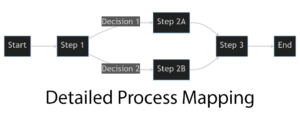If you’re starting out on a Six Sigma journey, or even if you’re a seasoned practitioner, you’ll understand that ‘precision’ and ‘accuracy’ are not mere buzzwords. They are, in fact, the essence of Six Sigma methodologies. One critical aspect that plays a pivotal role in maintaining these traits is the ‘sample size’ of your project. Yes, you heard it right! The sample size can greatly impact the validity and accuracy of your Six Sigma results.
But, what exactly is a ‘sample size’ and how does it intertwine with your Six Sigma project? Simply put, sample size refers to the number of observations or replicates (the data points) that are collected during a study or an experiment. In the context of Six Sigma, selecting the right sample size is crucial in order to make accurate and reliable conclusions about a process or system.
Determining the correct sample size for your Six Sigma project is not always straightforward. It involves consideration of various factors, from the nature of your project to the statistical tools you’re using. Fear not, this comprehensive guide aims to ease that process for you. We’re going to delve deeper into what a sample size is, why it matters, and how you can determine and calculate the right sample size for your Six Sigma project. Stick with us, and you’ll be a sample size whizz in no time!
Stay tuned as we answer some of the most frequently asked questions about sample size in Six Sigma projects, and help you navigate your Six Sigma journey with confidence.
In This Guide
- Understanding Sample Size in Six Sigma
- How do you determine what my sample size should be?
- How do you calculate sample size for a project?
- What is the sampling strategy in Six Sigma?
- How does the Sample Size Impact Your Six Sigma Project?
- Common Pitfalls in Sample Size Determination for Six Sigma Projects
- Conclusion: Mastering Sample Size in Six Sigma
Understanding Sample Size in Six Sigma
In the realm of Six Sigma, the term ‘sample size’ refers to the number of observations or data points that are gathered during a statistical study. These data points, when collected correctly and in sufficient quantity, provide us with a clear picture of the overall process, system, or phenomenon we’re studying.
But why is sample size such a big deal in Six Sigma? The answer is fairly straightforward. Six Sigma is all about accuracy, precision, and quality. The larger and more representative your sample size, the more accurate and reliable your analysis will be.
But here’s the catch: A bigger sample size does not always mean better results. It’s all about the right balance. You see, collecting a sample size that’s too large may unnecessarily complicate your project, consume excess resources, and take up valuable time. On the other hand, a sample size that’s too small might not capture enough information about the process or system you’re studying, leading to inaccurate results and flawed conclusions.
Therefore, understanding sample size and its significance in Six Sigma is a critical skill for anyone involved in process improvement. With the correct sample size, you can reduce variation, increase accuracy, and make more reliable decisions about your project. In the upcoming sections, we will guide you on how to determine and calculate the appropriate sample size for your Six Sigma project. Stay tuned!
How do you determine what my sample size should be?
Determining the right sample size for your Six Sigma project doesn’t have to be as complex as it sounds. With a clear understanding of your project’s objectives and constraints, you can more accurately pinpoint the optimal sample size. Let’s break down the process:
Define Your Objective
Every Six Sigma project starts with a clear objective. Whether you’re looking to pinpoint the cause of a problem, improve an existing process, or validate an hypothesis, your objective lays the groundwork for your entire project. It’s this objective that will guide you in determining what kind of data you need, how much of it you need, and thus, your sample size.
Assess Variability
Variability refers to how much your data is expected to vary. If you’re dealing with a process or a system with high variability, you’ll need a larger sample size to capture this variation accurately. Conversely, if the variability is low, you may be able to get by with a smaller sample size.
Consider Your Confidence Level
In the realm of statistics, the term ‘confidence level’ refers to the degree of certainty you want in your results. A higher confidence level means that you are more certain that your sample accurately represents the population. However, a higher confidence level requires a larger sample size. It’s important to strike a balance here – choose a confidence level that gives you reliable results without requiring an impractically large sample size.
Determine Your Allowable Error
The ‘allowable error’ or ‘margin of error’ is the range within which you are comfortable accepting results. The smaller your margin of error, the closer your sample data needs to be to your population data, and therefore, the larger your sample size needs to be.
Practicality Matters
Finally, you need to consider your practical constraints. How much time, resources, and budget do you have for this project? Even the most statistically perfect sample size is useless if you can’t feasibly collect and analyze that much data. So, consider what’s practical and feasible for your situation before finalizing your sample size.
To conclude, determining the right sample size is an art that balances statistical rigour with practical constraints. It might take some practice, but with these steps, you’ll be well on your way to mastering this crucial aspect of Six Sigma.
How do you calculate sample size for a project?

Now that you understand the factors influencing your sample size, you’re probably wondering, “How do I actually calculate it?” Don’t worry, we’re here to guide you through the process.
Define the Confidence Level and Margin of Error
To begin with, define your confidence level and margin of error, as discussed in the previous section. Commonly, a confidence level of 95% and a margin of error of 5% are chosen. However, these numbers can be adjusted according to the needs of your project.
Use a Sample Size Formula
There are several formulas available to calculate sample size. A commonly used one for a simple random sample is:
n = Z² * (p*(1-p)) / E²
In this equation:
- n is the sample size.
- Z is the z-score, which corresponds to the confidence level you’ve chosen (For a 95% confidence level, Z is 1.96).
- p is the estimated proportion of the population that has the attribute in question. If you don’t know, use 0.5 (50%) for maximum variability.
- E is the margin of error.
Adjust for Population Size
If you’re studying a small population, you’ll need to adjust your sample size to avoid sampling more individuals than actually exist in your population. You can use the following formula:
n’ = n / (1 + (n – 1) / N)
Here:
- n’ is the adjusted sample size.
- n is the sample size calculated in the previous step.
- N is the total population size.
Subscribe to our newsletter!
Consider the Response Rate
In many studies, not everyone you select will end up participating. This is particularly true in surveys. So, consider your expected response rate and adjust your sample size accordingly.
While these steps can help you calculate a theoretically sound sample size, remember the importance of practicality. If your calculated sample size isn’t feasible due to time, budget, or resource constraints, you may need to adjust your confidence level, margin of error, or both, to arrive at a more realistic number.
In conclusion, calculating sample size involves a blend of statistical methods and practical adjustments. Mastering this balance is a key aspect of successful Six Sigma projects.
What is the sampling strategy in Six Sigma?
Sampling strategy is an important part of your Six Sigma project planning. The strategy you choose can significantly impact your study’s effectiveness, so let’s dive deeper into each strategy:

Simple Random Sampling
In Simple Random Sampling, every member of the population has an equal chance of being selected. It’s the easiest strategy to implement and often provides a representative sample, making it a great choice when the population is relatively homogeneous. This strategy, however, may not be ideal when your population is large or geographically spread out.
Stratified Sampling
Stratified Sampling is useful when your population can be divided into distinct groups or “strata”. You divide the population into these groups based on specific characteristics and then select samples from each group. The major benefit of this strategy is that it ensures each stratum is adequately represented in your sample. For instance, if you’re studying a manufacturing process that involves different shifts or different machines, stratified sampling can ensure each shift or machine is properly represented.
Systematic Sampling
Systematic Sampling involves selecting samples at fixed intervals, like every 10th or 100th item. This method is particularly useful in manufacturing or production settings where items are processed in a sequence. One advantage of this approach is its simplicity, but it requires that the order of the population is not related to the characteristics being measured, to avoid bias.
Cluster Sampling
Cluster Sampling is beneficial when your population is large and geographically spread out. You divide the population into clusters or groups, and select a few clusters randomly. All members within these selected clusters form your sample. This strategy can save time and resources when your population is widely dispersed, but it may introduce more variability into your sample, as individuals within clusters may be similar to each other.
Convenience Sampling
Convenience Sampling involves choosing samples that are easiest to obtain. It’s a quick and easy method, but it’s also the least statistically rigorous. This strategy can be useful in exploratory phases or when other strategies are impractical due to time or resource constraints. However, because it often doesn’t represent the population well, it’s not recommended for final conclusions or decisions.
Remember, there’s no one-size-fits-all strategy. Choosing the right sampling strategy for your Six Sigma project depends on your population’s nature, your study’s purpose, and the resources available to you. By understanding the pros and cons of each strategy, you’ll be able to choose the most effective approach for your specific project.
How does the Sample Size Impact Your Six Sigma Project?
Understanding the impact of sample size on your Six Sigma project can help you make better decisions during your project planning and execution. Let’s dive deeper into the crucial role sample size plays:
Accuracy of Results
Sample size directly affects the accuracy of your project results. A larger sample size can help you achieve more accurate results as it provides a better approximation of the entire population. But remember, while increasing sample size can improve accuracy, it’s crucial to balance this with your resources and timeline.
Detecting Effects
A larger sample size can help you detect smaller effects or differences. In Six Sigma projects, detecting these subtle changes can be critical to identifying issues or verifying improvements. But again, remember the trade-off between detecting smaller effects and the resources required.
Confidence Levels
Sample size also impacts the confidence level of your study. The larger your sample size, the higher your confidence level can be, leading to more robust conclusions. But, a high confidence level requires a larger sample, which might not always be feasible.
Risk of Errors
Finally, your sample size affects the risk of statistical errors. A larger sample size reduces the risk of Type I and Type II errors, enhancing the validity and reliability of your study.
In conclusion, sample size plays a pivotal role in your Six Sigma project. It affects everything from the accuracy and reliability of your results to your ability to detect small changes and generalize your findings. So, understanding its impact can greatly enhance your Six Sigma project’s effectiveness and success.
Common Pitfalls in Sample Size Determination for Six Sigma Projects
In your Six Sigma journey, being aware of common pitfalls in determining sample size can save you from critical errors. Here are some commonly observed pitfalls and how to avoid them:
Ignoring Practical Constraints
While it’s important to strive for statistical rigour, ignoring practical constraints can lead to unrealistic expectations and eventually, project failure. Always consider your time, budget, and resources before finalizing your sample size.
Oversampling
Oversampling, or gathering more data than necessary, can lead to wasted resources and time. Remember that more data does not always mean better results. Strive for the optimal balance between accuracy and practicality.
Neglecting Variability
Ignoring the inherent variability in your process can lead to an inappropriate sample size, affecting the accuracy of your results. Ensure that you properly assess variability before determining your sample size.
Forgetting the Purpose of the Study
The purpose of your study should guide your sample size determination. If your study aims to detect small changes, you might need a larger sample size compared to a study aimed at identifying large, glaring issues.
Overlooking Sampling Bias
Avoid choosing a sample that is convenient rather than representative of the population. This bias can skew your results and make your conclusions invalid.
In conclusion, while determining sample size for your Six Sigma projects, being aware of these common pitfalls can help you avoid them. This can lead to more effective and successful projects. It’s all about planning carefully, understanding your process and data, and making informed decisions.
Conclusion: Mastering Sample Size in Six Sigma
Mastering the concept of sample size is a vital skill for any Six Sigma practitioner. It forms the foundation of your data collection process, directly impacting the accuracy and reliability of your results.
From understanding the factors that influence your sample size to calculating it accurately, from choosing the right sampling strategy to understanding its impact on your project – each aspect plays a critical role in the success of your Six Sigma project.
Avoiding common pitfalls and keeping practical constraints in mind are just as important. By doing so, you can ensure that your sample size determination is not only statistically sound but also practically feasible.
In a nutshell, navigating the complexities of sample size in Six Sigma might seem daunting at first, but with a good grasp of the fundamentals and a practical approach, you can master it. So, embark on your Six Sigma journey with confidence, knowing that you have the tools and knowledge to determine the right sample size for your projects.
Remember, the road to Six Sigma mastery is a continuous journey of learning and application. Stay curious, keep exploring, and continue improving!
That’s all for this comprehensive guide on determining the right sample size for your Six Sigma project. We hope it has provided valuable insights and useful tips for your Six Sigma practice. If you have any more questions or need further help, don’t hesitate to reach out. Happy mastering!
Subscribe to our newsletter!





